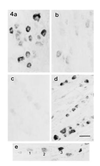Down-regulation of transcripts for Na channel alpha-SNS in spinal sensory neurons following axotomy
- PMID: 8962162
- PMCID: PMC26243
- DOI: 10.1073/pnas.93.25.14950
Down-regulation of transcripts for Na channel alpha-SNS in spinal sensory neurons following axotomy
Abstract
Spinal sensory (dorsal root ganglion; DRG) neurons display slowly inactivating, tetrodotoxin-resistant (TTX-R), and rapidly inactivating, TTX-sensitive (TTX-S) Na currents. Attenuation of the TTX-R Na current and enhancement of TTX-S Na current have been demonstrated in cutaneous afferent DRG neurons in the adult rat after axotomy and may underlie abnormal bursting. We show here that steady-state levels of transcripts encoding the alpha-SNS subunit, which is associated with a slowly inactivating, TTX-R current when expressed in oocytes, are reduced significantly 5 days following axotomy of DRG neurons, and continue to be expressed at reduced levels, even after 210 days. Steady-state levels of alpha-III transcripts, which are present at low levels in control DRG neurons, show a pattern of transiently increased expression. In situ hybridization using alpha-SNS- and alpha-III-specific riboprobes showed a decreased signal for alpha-SNS, and an increased signal for alpha-III, in both large and small DRG neurons following axotomy. Reduced levels of alpha-SNS may explain the selective loss of slowly inactivating, TTX-R current. The abnormal electrophysiological properties of DRG neurons following axonal injury thus appear to reflect a switch in Na channel gene expression.
Figures




References
Publication types
MeSH terms
Substances
Associated data
- Actions
- Actions
LinkOut - more resources
Full Text Sources
Other Literature Sources
Molecular Biology Databases

